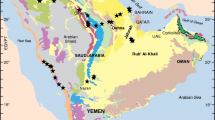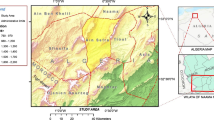Abstract
The reconstruction of Lebanon has started after more than 15 years of devastating civil wars. There is an urgent need today to evaluated sources of ma for the construction industry. Extensive surveys and investigations were carried out, covering 80 percent of the Lebanese territory, to locate the major sand resources of Lebanon. The part of Lebanon occupied by Israel was excluded from the survey for security reasons. Previous data from geological maps and research reports were used as background information. Forty-one major sand quarries were located, described, and sampled. The description was made as to their administrative coverage and to nature. The naturally occurring sands come mainly from the basal Cretaceous rather loosely consolidated sandstone formation, and to a lesser extent from various Quaternary deposits.
The Cretaceous sands are quartzitic, whitish to yellow with iron oxides cementation, mostly medium-grained, and intercalated with minor other lithologies. They are distributed in the mountains but used all over the country. The coastal cities, major centers of demand, use in addition the local Quaternary sands. In several segments along the coast, illegal extraction of Quaternary beach sands is taking place.
Further engineering geological investigations and materials testing are being conducted on the collected samples. The results will be presented in another paper.
Résumé
La reconstruction du Liban a été entamée après plus de quinze années de guerres civiles dévastatrices. Il est donc urgent aujourd'hui d'évaluer les sources de matériaux pour l'industrie de construction. De vastes investigations couvrant 80% du territoire libanais ont été réalisées en vue de situer les ressources majeures de sable. Des données antérieures fournies par des cartes géologiques et des rapports de recherche ont été utilisées comme information de base. De plus, quarante-et-une carrières ont été situées et décrites, avec prélèvement d'échantillons. Les sites sont décrits par rapport à leur nature et à la division administrative. Les sables existant naturellement proviennent principalement de la base du Crétacé, constitué de grès plutôt faiblement consolidés. Les sables peuvent également exister, mais moins abondants, parmi les divers dépôts du Quaternaire.
Le grès du Crétacé sont quartzeux et de couleur blanchâtre virant au jaune avec des cimentations d'oxydes de Fer. Les grains sont le plus souvent de dimension moyenne et les sables intercalés avec d'autres faciès secondaires. D'autre part, bien que ces sables soient situés dans les montagnes, ils sont utilisés à travers tout le pays. Les villes côtières, qui sont les centres principaux de consommation, utilisent également les sables locaux du Quaternaire. Dans plusieurs secteurs. le long de la côte, des extractions illégales de sable de plage du Quaternaire ont également lieu.
Des études géotechniques pour caractériser ces matériaux ont été réalisées et feront l'objet d'un autre article.
Similar content being viewed by others
References
DUBERTRET L. (1951): Révision de la stratigraphie du Crétacé du Liban. Notes-Mem-Syrie-Liban 2 pp. 43–73, Cartes géologiques du Liban au 50 000 e, Beyrouth.
HAJAL M. (1974): Etude des sables de carrières et agrégats. National Council for Scientific Research, Unpublished Report, Lebanon.
KABBANI M. (1967): Various types of sand in Lebanon and their effect on concrete and mortar. Masters Thesis., American University of Beirut, Beirut, Lebanon.
KANAAN F. (1966): Sedimentary structures and thickness and facies variations in the basal Cretaceous sandstones of Central Lebanon. Masters Thesis, American University of Beirut, Beirut, Lebanon.
KHAWLIE M. & HINAI K. (1979): The Neogene conglomerates of Beka'a, Lebanon, a construction material source. Proc. 1st. Geological Congress of Middle East, Turkey, p. 221–270.
KHAWLIE M. & HINAI K. (1980): Geology and production of construction material resources of Lebanon: A preliminary study. Engineering Geology, 15:223–232.
KLINK S. & MOKADDAM M. (1974): Properties and deformation-time under local climatic conditions of concrete made with aggregates from various regions of Lebanon. National Council for Scientific Research. Unpublished Report. Lebanon.
MASAAD M. (1976): Origin and environment of deposition of Lebanon Basal Sandstones. Eclogae Geol. Helv. 69/1: 85–91.
SABBAGH G. (1974): Etude géologique des carrières de sable d'agrégat de calcaire et d'argile. National Council for Scientific Research. Unpublished Report, Lebanon.
WAKIM S. (1967): Petrography of the basal Cretaceous sandstones of Central Lebanon. Masters Thesis, American University of Beirut Beirut, Lebanon.
Author information
Authors and Affiliations
Rights and permissions
About this article
Cite this article
Hamad, B.S., Yassine, M.Y. & Khawlie, M.R. A survey study on geology and location of major sand resources in Lebanon, eastern mediterranean. Bulletin of the International Association of Engineering Geology 53, 39–48 (1996). https://doi.org/10.1007/BF02594939
Published:
Issue Date:
DOI: https://doi.org/10.1007/BF02594939




